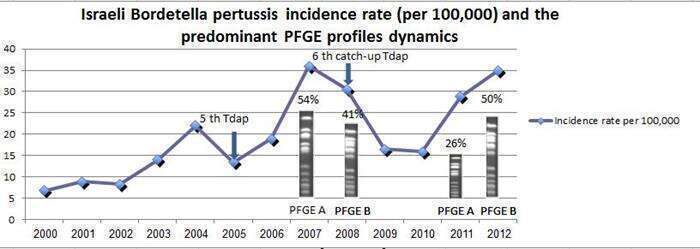Background: High pertussis vaccination coverage may prompt genetic drift in the bacterium leading to the emergence of new disease- causing strains. We recently described two dominant, closely related pulse field gel electrophoresis (PFGE) profiles, during 2007-2008, named A and B. Profiles C and D were also identified. The predominant PFGE profile A, had the same PFGE cluster as the dominant European strain, 1999 to 2004 (PFGE cluster IVβ), whereas profile B was identical to the PFGE cluster IVα.
Aim: To use PFGE to analyze select circulating pertussis isolates during the high incidence rate years, 2009-2012, one year after the initiation of an adolescent booster dose.
Methods: PFGE utilizing the SpeI restriction enzyme on 38 pertussis isolates.
Results: Several PFGE restriction patterns from 2009-2012 were identified and referenced to our 2007-2008 restriction patterns A, B, C, and D. Profile A decreased from 54% (n=44) to 26% (n=10), p<0.006, whereas B increased from 41% (n=34) to 50% (n=18), p>0.43, respectively. Profiles C and D disappeared and new profiles, E (n=2, 5%), F (n=1, 3%), G (n=3, 8%), H (n=1, 3%), and I (n=2, 5%) emerged.
Conclusions:
We found a significant decrease in the frequency of PFGE profile A (cluster IVβ) and an increase in B (cluster IVα) a few years after the fifth and sixth booster doses were introduced. New PFGE profiles were identified. Similar dynamics in pertussis PFGE clusters have also been described in Europe. Studies should explore whether this genetic drift may be prompted by the recent vaccine selection pressure.


